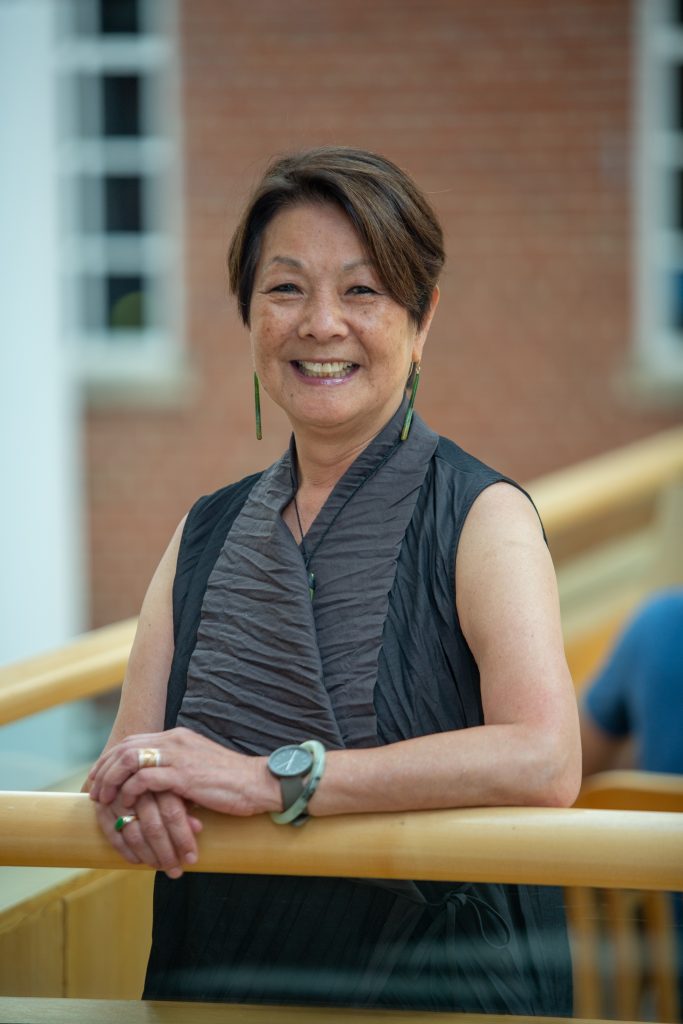The Equity Concentration
October 8, 2018
An interdisciplinary approach to eliminating health inequities
Health equity. Social justice. Human rights.

Program co-leaders Drs. Courtney Woods, Asia Maselko and Anissa Vines (left to right) meet to discuss plans for the Equity concentration, one of the 12 new specialized fields of study within the Gillings School’s Master of Public Health degree.
“These concepts are foundational to public health research and practice,” says Anissa Vines, PhD, assistant professor of epidemiology at the Gillings School. “This is what our field is about – ensuring that everyone has access to the resources they need to be healthy and to live life to the fullest, physically, mentally and socially.”
Vines, former associate director of the School’s Program on Ethnicity, Culture and Health Outcomes (ECHO), is now a co-lead for the new Master of Public Health (MPH) concentration Health Equity, Social Justice and Human Rights.
Other co-leads are Joanna “Asia” Maselko, ScD, associate professor of epidemiology, Courtney Woods, PhD, assistant professor of environmental sciences and engineering, and Geni Eng, DrPH, professor of health behavior. Allison Aiello, PhD, professor of epidemiology, also was a founding co-leader of the concentration.
Together, they represent a wealth of varied experiences and approaches to achieving health equity and eliminating health disparities.
Students in the cross-cutting, interdisciplinary Equity concentration can look forward to developing skills that will help them improve population health through measuring, identifying and intervening to eliminate health inequities and improve social justice and human rights.
 “This concentration is so important,” Vines says. “Public health experts have worked for decades – centuries – to reduce health disparities, but the inequities in health still haven’t been eliminated.”
“This concentration is so important,” Vines says. “Public health experts have worked for decades – centuries – to reduce health disparities, but the inequities in health still haven’t been eliminated.”
The Equity concentration will be unique in the ways it helps students understand the social determinants of health and outlines the historical underpinnings that have structured how people live, work and play.
“This context,” Vines says, “will enable our students to think creatively about innovative solutions that address root causes standing between some populations and better health.”
“Our co-leads are from three traditional Gillings School departments, and we also have strong representation and teaching from other departments,” says Maselko. “Being a co-led structure makes us stronger, as students will be exposed to diverse approaches to the topics we cover. We are very excited about the interdisciplinary training our students will receive.”
“Drs. Maselko and Vines represent epidemiology and focus on social determinants in study design, data interpretation and data analysis,” says Woods. “I use community-driven approaches for environmental exposure, risk and health impact assessment, and Dr. Eng, along with others from the field of health behavior, brings critical theory for assessing public health problems and engaging communities to help design effective, multi-level solutions. Other core faculty members from our leadership team will help students understand the importance of using an equity lens in policy and program design.”
“Local community partners will be involved in the fieldwork and training of our students, offering them access to individuals and organizations who are involved in developing solutions,” says Vines. “In addition to empowering students to make an immediate impact, the concentration will provide the leadership experience and confidence graduates will need as they move into the public health workforce.”
Eng notes that the Gillings School’s emphasis on system change interventions that enhance health equity for everyone requires establishing partnerships both with health care organizations and communities that experience inequities.
“Students will learn how to develop innovative strategies for shifting decision-making power through community-engaged work – and through action that promotes equity in health outcomes,” Eng says.

“Students will learn how to develop innovative strategies for shifting decision-making power through community-engaged work.” —Dr. Geni Eng
Vines says many students and faculty members helped develop and supported the formation of a concentration that focused on equity, social justice and human rights.
“The enthusiasm and encouragement of our students was an integral driver for developing the concentration, and their input helped shape its overall goals,” she says. In the course of the two-year program, students also will learn to evaluate scientific literature and examine data across public sectors; apply concepts, theories, and frameworks to address the social determinants of health and inequities; evaluate the impact of programs and policies; and develop culturally appropriate health communications.
As graduates, students will be prepared for a broad range of local and global careers within health agencies, nonprofit organizations, academic institutions, health care organizations and the private sector. They may choose to develop or help change health policy, contribute to the urban planning sector or housing market, conduct scientific research, or bring their unique expertise to settings as diverse as schools, hospitals and the criminal justice system.
“Our goal with this concentration,” Vines says, “is to infuse the workforce with individuals trained to think creatively about addressing historical racial, ethnic and geographic health inequities. Public health is everywhere, and inequities are, too. Our graduates will be able to make an impact in any sector they choose to enter.”
—Jennie Saia
Carolina Public Health is a publication of the University of North Carolina at Chapel Hill Gillings School of Global Public Health. To view previous issues, please visit sph.unc.edu/cph.
